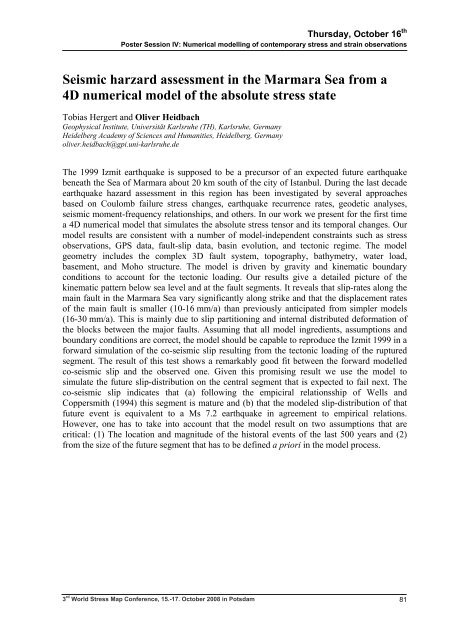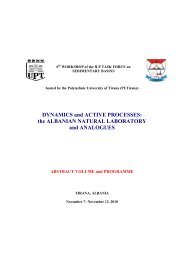World Stress Map Conference - International Lithosphere Program ...
World Stress Map Conference - International Lithosphere Program ...
World Stress Map Conference - International Lithosphere Program ...
You also want an ePaper? Increase the reach of your titles
YUMPU automatically turns print PDFs into web optimized ePapers that Google loves.
Thursday, October 16 th<br />
Poster Session IV: Numerical modelling of contemporary stress and strain observations<br />
Seismic harzard assessment in the Marmara Sea from a<br />
4D numerical model of the absolute stress state<br />
Tobias Hergert and Oliver Heidbach<br />
Geophysical Institute, Universität Karlsruhe (TH), Karlsruhe, Germany<br />
Heidelberg Academy of Sciences and Humanities, Heidelberg, Germany<br />
oliver.heidbach@gpi.uni-karlsruhe.de<br />
The 1999 Izmit earthquake is supposed to be a precursor of an expected future earthquake<br />
beneath the Sea of Marmara about 20 km south of the city of Istanbul. During the last decade<br />
earthquake hazard assessment in this region has been investigated by several approaches<br />
based on Coulomb failure stress changes, earthquake recurrence rates, geodetic analyses,<br />
seismic moment-frequency relationships, and others. In our work we present for the first time<br />
a 4D numerical model that simulates the absolute stress tensor and its temporal changes. Our<br />
model results are consistent with a number of model-independent constraints such as stress<br />
observations, GPS data, fault-slip data, basin evolution, and tectonic regime. The model<br />
geometry includes the complex 3D fault system, topography, bathymetry, water load,<br />
basement, and Moho structure. The model is driven by gravity and kinematic boundary<br />
conditions to account for the tectonic loading. Our results give a detailed picture of the<br />
kinematic pattern below sea level and at the fault segments. It reveals that slip-rates along the<br />
main fault in the Marmara Sea vary significantly along strike and that the displacement rates<br />
of the main fault is smaller (10-16 mm/a) than previously anticipated from simpler models<br />
(16-30 mm/a). This is mainly due to slip partitioning and internal distributed deformation of<br />
the blocks between the major faults. Assuming that all model ingredients, assumptions and<br />
boundary conditions are correct, the model should be capable to reproduce the Izmit 1999 in a<br />
forward simulation of the co-seismic slip resulting from the tectonic loading of the ruptured<br />
segment. The result of this test shows a remarkably good fit between the forward modelled<br />
co-seismic slip and the observed one. Given this promising result we use the model to<br />
simulate the future slip-distribution on the central segment that is expected to fail next. The<br />
co-seismic slip indicates that (a) following the empiciral relationsship of Wells and<br />
Coppersmith (1994) this segment is mature and (b) that the modeled slip-distribution of that<br />
future event is equivalent to a Ms 7.2 earthquake in agreement to empirical relations.<br />
However, one has to take into account that the model result on two assumptions that are<br />
critical: (1) The location and magnitude of the historal events of the last 500 years and (2)<br />
from the size of the future segment that has to be defined a priori in the model process.<br />
3 rd <strong>World</strong> <strong>Stress</strong> <strong>Map</strong> <strong>Conference</strong>, 15.-17. October 2008 in Potsdam<br />
81




